Globalization in 2019: A Literature Review for Business Students
VerifiedAdded on 2022/12/16
|6
|1351
|355
Literature Review
AI Summary
This literature review examines the state of globalization in 2019, prompted by the article "The State of Globalization in 2019, and What It Means for Strategists" by Ghemawat and Altman. The review explores the shifts in globalization since 2016, considering the interplay between economic fundamentals and policy threats, and analyzes the key questions raised by the article. It addresses how companies should compete, where they should compete, how they should organize, and how to better engage with society in the context of globalization. The review incorporates insights from various sources, including Bonizzi (2017), Bozyk (2019), and others, to provide a comprehensive understanding of the challenges and opportunities in the global business environment. The paper concludes with a discussion on the evolving strategies and considerations for businesses operating in a globalized world, emphasizing the importance of adapting to changing market dynamics and societal expectations.
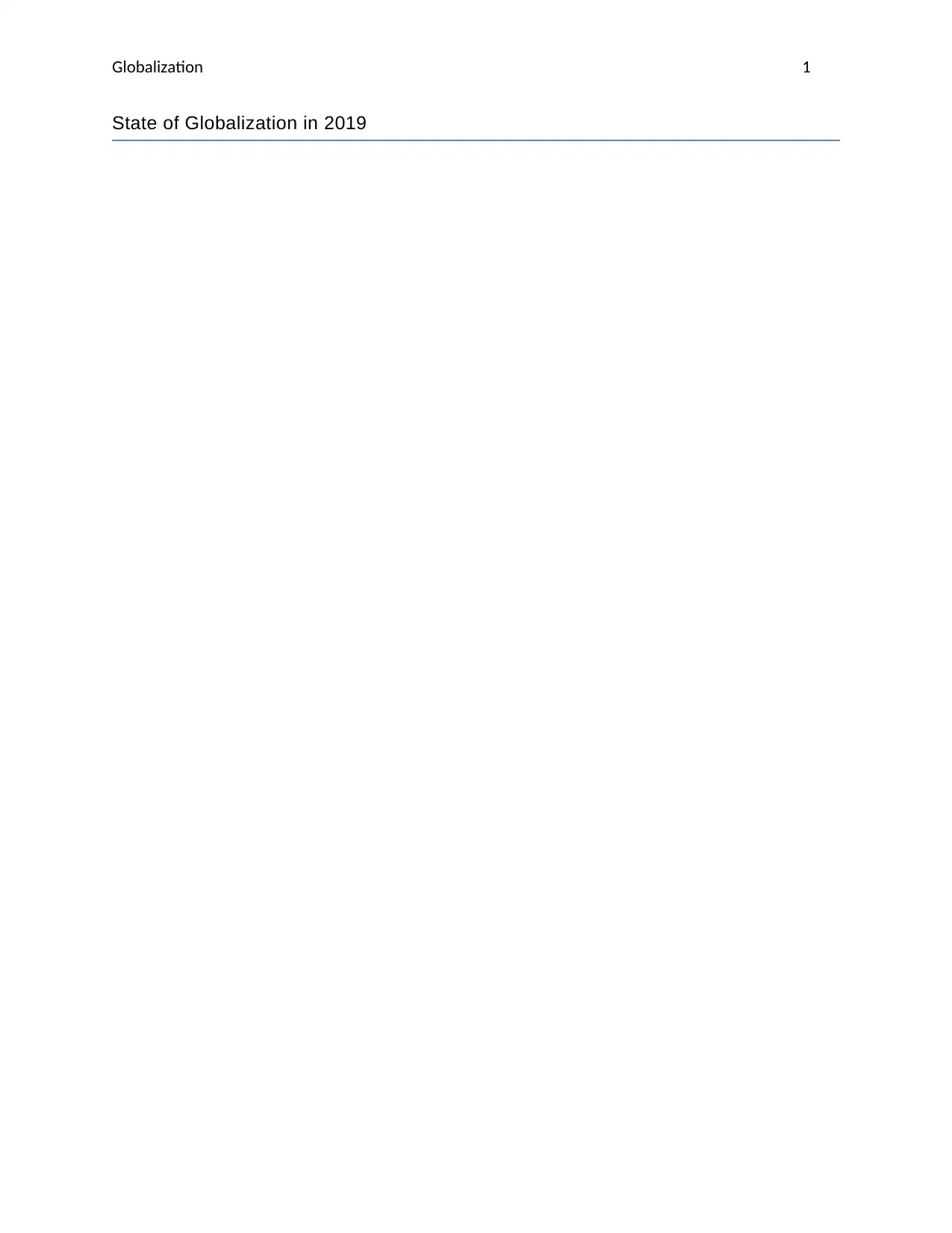
Globalization 1
State of Globalization in 2019
State of Globalization in 2019
Paraphrase This Document
Need a fresh take? Get an instant paraphrase of this document with our AI Paraphraser
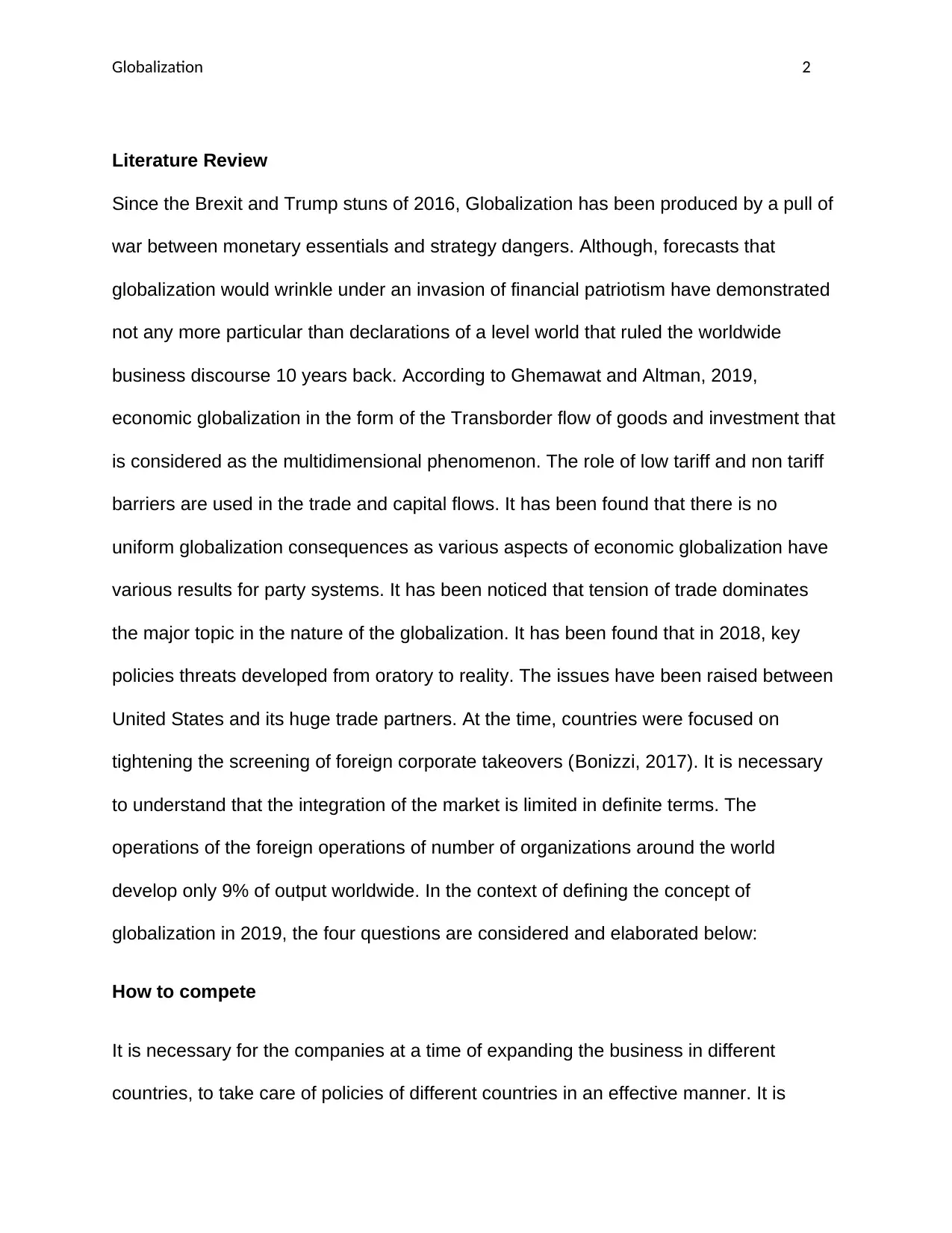
Globalization 2
Literature Review
Since the Brexit and Trump stuns of 2016, Globalization has been produced by a pull of
war between monetary essentials and strategy dangers. Although, forecasts that
globalization would wrinkle under an invasion of financial patriotism have demonstrated
not any more particular than declarations of a level world that ruled the worldwide
business discourse 10 years back. According to Ghemawat and Altman, 2019,
economic globalization in the form of the Transborder flow of goods and investment that
is considered as the multidimensional phenomenon. The role of low tariff and non tariff
barriers are used in the trade and capital flows. It has been found that there is no
uniform globalization consequences as various aspects of economic globalization have
various results for party systems. It has been noticed that tension of trade dominates
the major topic in the nature of the globalization. It has been found that in 2018, key
policies threats developed from oratory to reality. The issues have been raised between
United States and its huge trade partners. At the time, countries were focused on
tightening the screening of foreign corporate takeovers (Bonizzi, 2017). It is necessary
to understand that the integration of the market is limited in definite terms. The
operations of the foreign operations of number of organizations around the world
develop only 9% of output worldwide. In the context of defining the concept of
globalization in 2019, the four questions are considered and elaborated below:
How to compete
It is necessary for the companies at a time of expanding the business in different
countries, to take care of policies of different countries in an effective manner. It is
Literature Review
Since the Brexit and Trump stuns of 2016, Globalization has been produced by a pull of
war between monetary essentials and strategy dangers. Although, forecasts that
globalization would wrinkle under an invasion of financial patriotism have demonstrated
not any more particular than declarations of a level world that ruled the worldwide
business discourse 10 years back. According to Ghemawat and Altman, 2019,
economic globalization in the form of the Transborder flow of goods and investment that
is considered as the multidimensional phenomenon. The role of low tariff and non tariff
barriers are used in the trade and capital flows. It has been found that there is no
uniform globalization consequences as various aspects of economic globalization have
various results for party systems. It has been noticed that tension of trade dominates
the major topic in the nature of the globalization. It has been found that in 2018, key
policies threats developed from oratory to reality. The issues have been raised between
United States and its huge trade partners. At the time, countries were focused on
tightening the screening of foreign corporate takeovers (Bonizzi, 2017). It is necessary
to understand that the integration of the market is limited in definite terms. The
operations of the foreign operations of number of organizations around the world
develop only 9% of output worldwide. In the context of defining the concept of
globalization in 2019, the four questions are considered and elaborated below:
How to compete
It is necessary for the companies at a time of expanding the business in different
countries, to take care of policies of different countries in an effective manner. It is
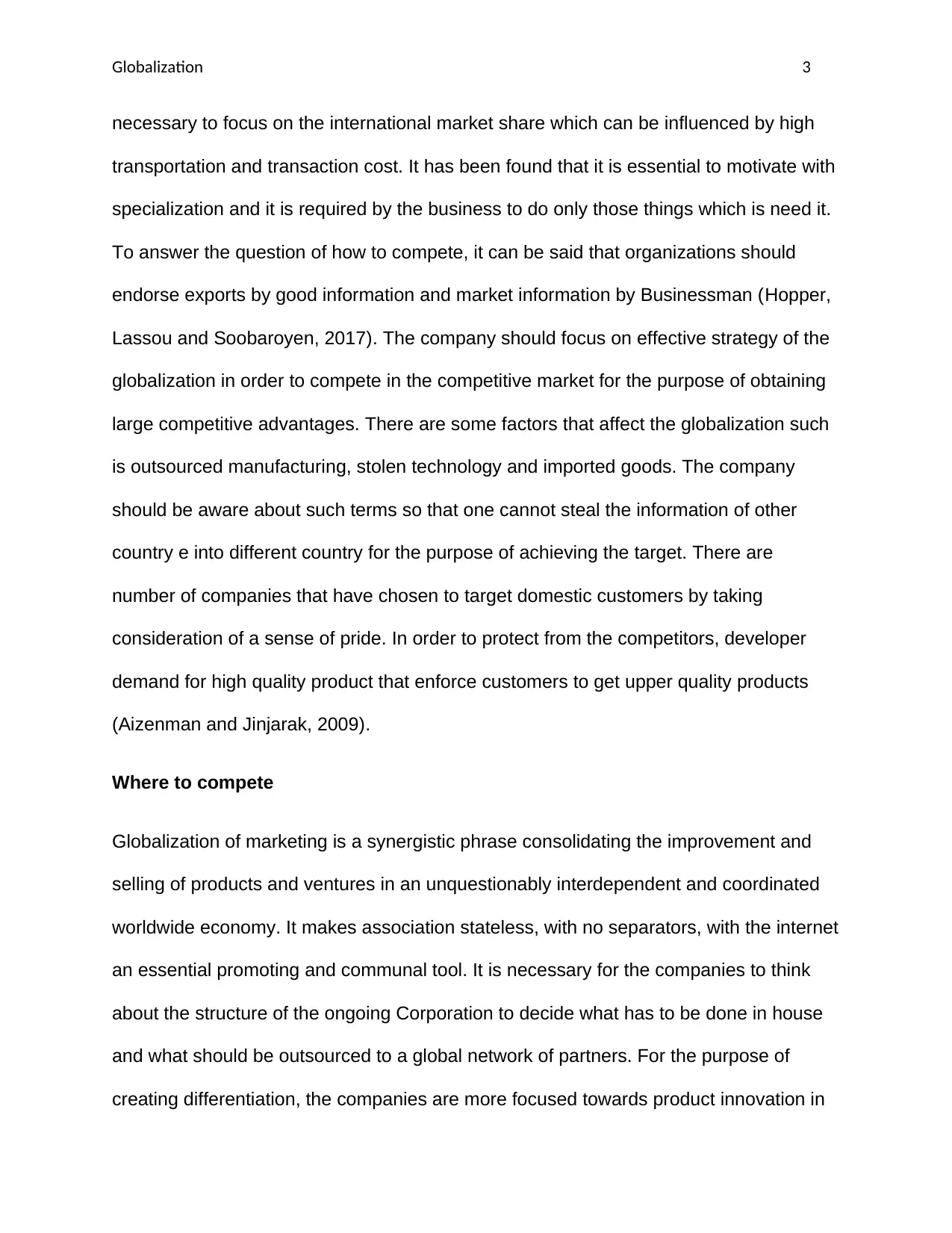
Globalization 3
necessary to focus on the international market share which can be influenced by high
transportation and transaction cost. It has been found that it is essential to motivate with
specialization and it is required by the business to do only those things which is need it.
To answer the question of how to compete, it can be said that organizations should
endorse exports by good information and market information by Businessman (Hopper,
Lassou and Soobaroyen, 2017). The company should focus on effective strategy of the
globalization in order to compete in the competitive market for the purpose of obtaining
large competitive advantages. There are some factors that affect the globalization such
is outsourced manufacturing, stolen technology and imported goods. The company
should be aware about such terms so that one cannot steal the information of other
country e into different country for the purpose of achieving the target. There are
number of companies that have chosen to target domestic customers by taking
consideration of a sense of pride. In order to protect from the competitors, developer
demand for high quality product that enforce customers to get upper quality products
(Aizenman and Jinjarak, 2009).
Where to compete
Globalization of marketing is a synergistic phrase consolidating the improvement and
selling of products and ventures in an unquestionably interdependent and coordinated
worldwide economy. It makes association stateless, with no separators, with the internet
an essential promoting and communal tool. It is necessary for the companies to think
about the structure of the ongoing Corporation to decide what has to be done in house
and what should be outsourced to a global network of partners. For the purpose of
creating differentiation, the companies are more focused towards product innovation in
necessary to focus on the international market share which can be influenced by high
transportation and transaction cost. It has been found that it is essential to motivate with
specialization and it is required by the business to do only those things which is need it.
To answer the question of how to compete, it can be said that organizations should
endorse exports by good information and market information by Businessman (Hopper,
Lassou and Soobaroyen, 2017). The company should focus on effective strategy of the
globalization in order to compete in the competitive market for the purpose of obtaining
large competitive advantages. There are some factors that affect the globalization such
is outsourced manufacturing, stolen technology and imported goods. The company
should be aware about such terms so that one cannot steal the information of other
country e into different country for the purpose of achieving the target. There are
number of companies that have chosen to target domestic customers by taking
consideration of a sense of pride. In order to protect from the competitors, developer
demand for high quality product that enforce customers to get upper quality products
(Aizenman and Jinjarak, 2009).
Where to compete
Globalization of marketing is a synergistic phrase consolidating the improvement and
selling of products and ventures in an unquestionably interdependent and coordinated
worldwide economy. It makes association stateless, with no separators, with the internet
an essential promoting and communal tool. It is necessary for the companies to think
about the structure of the ongoing Corporation to decide what has to be done in house
and what should be outsourced to a global network of partners. For the purpose of
creating differentiation, the companies are more focused towards product innovation in
⊘ This is a preview!⊘
Do you want full access?
Subscribe today to unlock all pages.

Trusted by 1+ million students worldwide
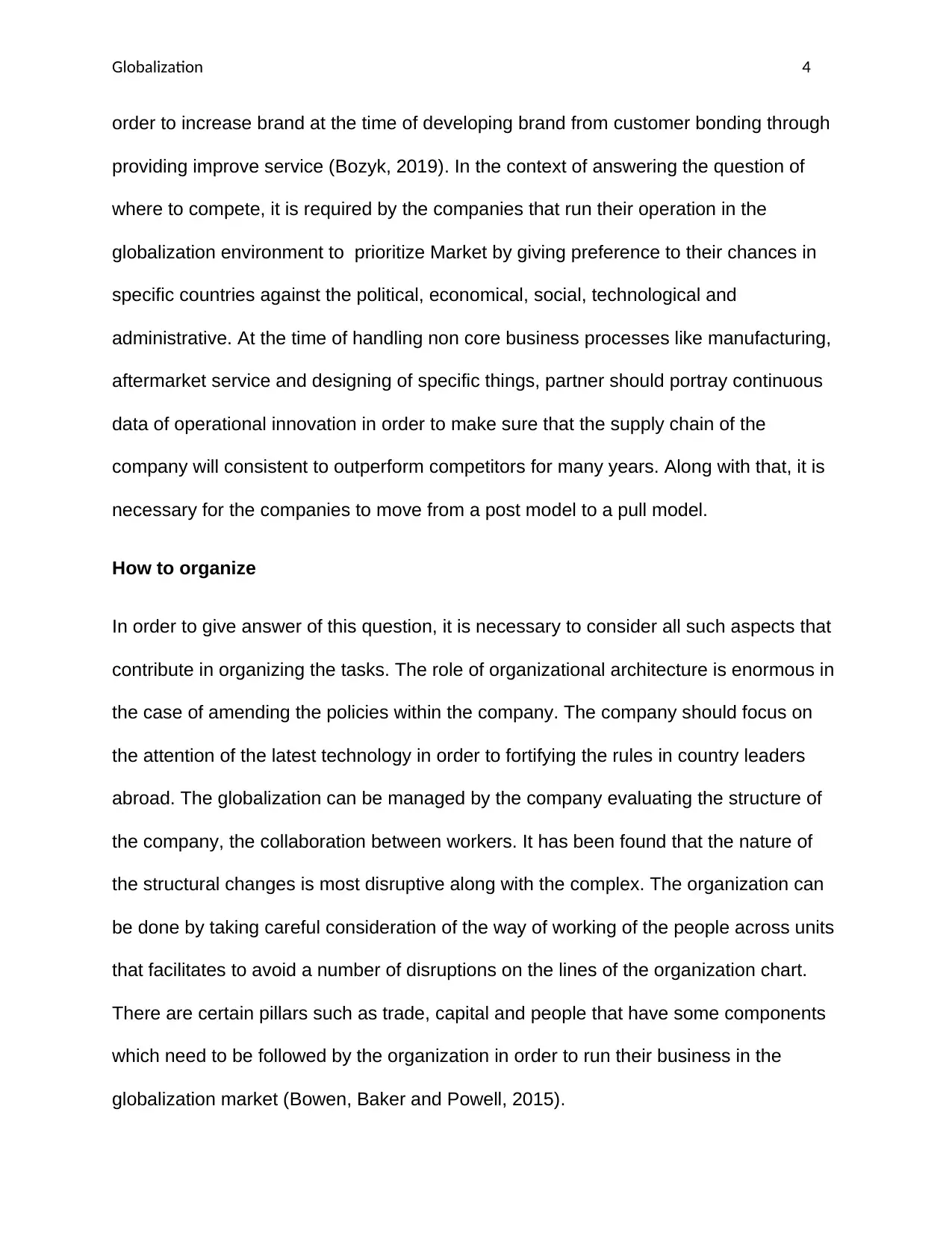
Globalization 4
order to increase brand at the time of developing brand from customer bonding through
providing improve service (Bozyk, 2019). In the context of answering the question of
where to compete, it is required by the companies that run their operation in the
globalization environment to prioritize Market by giving preference to their chances in
specific countries against the political, economical, social, technological and
administrative. At the time of handling non core business processes like manufacturing,
aftermarket service and designing of specific things, partner should portray continuous
data of operational innovation in order to make sure that the supply chain of the
company will consistent to outperform competitors for many years. Along with that, it is
necessary for the companies to move from a post model to a pull model.
How to organize
In order to give answer of this question, it is necessary to consider all such aspects that
contribute in organizing the tasks. The role of organizational architecture is enormous in
the case of amending the policies within the company. The company should focus on
the attention of the latest technology in order to fortifying the rules in country leaders
abroad. The globalization can be managed by the company evaluating the structure of
the company, the collaboration between workers. It has been found that the nature of
the structural changes is most disruptive along with the complex. The organization can
be done by taking careful consideration of the way of working of the people across units
that facilitates to avoid a number of disruptions on the lines of the organization chart.
There are certain pillars such as trade, capital and people that have some components
which need to be followed by the organization in order to run their business in the
globalization market (Bowen, Baker and Powell, 2015).
order to increase brand at the time of developing brand from customer bonding through
providing improve service (Bozyk, 2019). In the context of answering the question of
where to compete, it is required by the companies that run their operation in the
globalization environment to prioritize Market by giving preference to their chances in
specific countries against the political, economical, social, technological and
administrative. At the time of handling non core business processes like manufacturing,
aftermarket service and designing of specific things, partner should portray continuous
data of operational innovation in order to make sure that the supply chain of the
company will consistent to outperform competitors for many years. Along with that, it is
necessary for the companies to move from a post model to a pull model.
How to organize
In order to give answer of this question, it is necessary to consider all such aspects that
contribute in organizing the tasks. The role of organizational architecture is enormous in
the case of amending the policies within the company. The company should focus on
the attention of the latest technology in order to fortifying the rules in country leaders
abroad. The globalization can be managed by the company evaluating the structure of
the company, the collaboration between workers. It has been found that the nature of
the structural changes is most disruptive along with the complex. The organization can
be done by taking careful consideration of the way of working of the people across units
that facilitates to avoid a number of disruptions on the lines of the organization chart.
There are certain pillars such as trade, capital and people that have some components
which need to be followed by the organization in order to run their business in the
globalization market (Bowen, Baker and Powell, 2015).
Paraphrase This Document
Need a fresh take? Get an instant paraphrase of this document with our AI Paraphraser
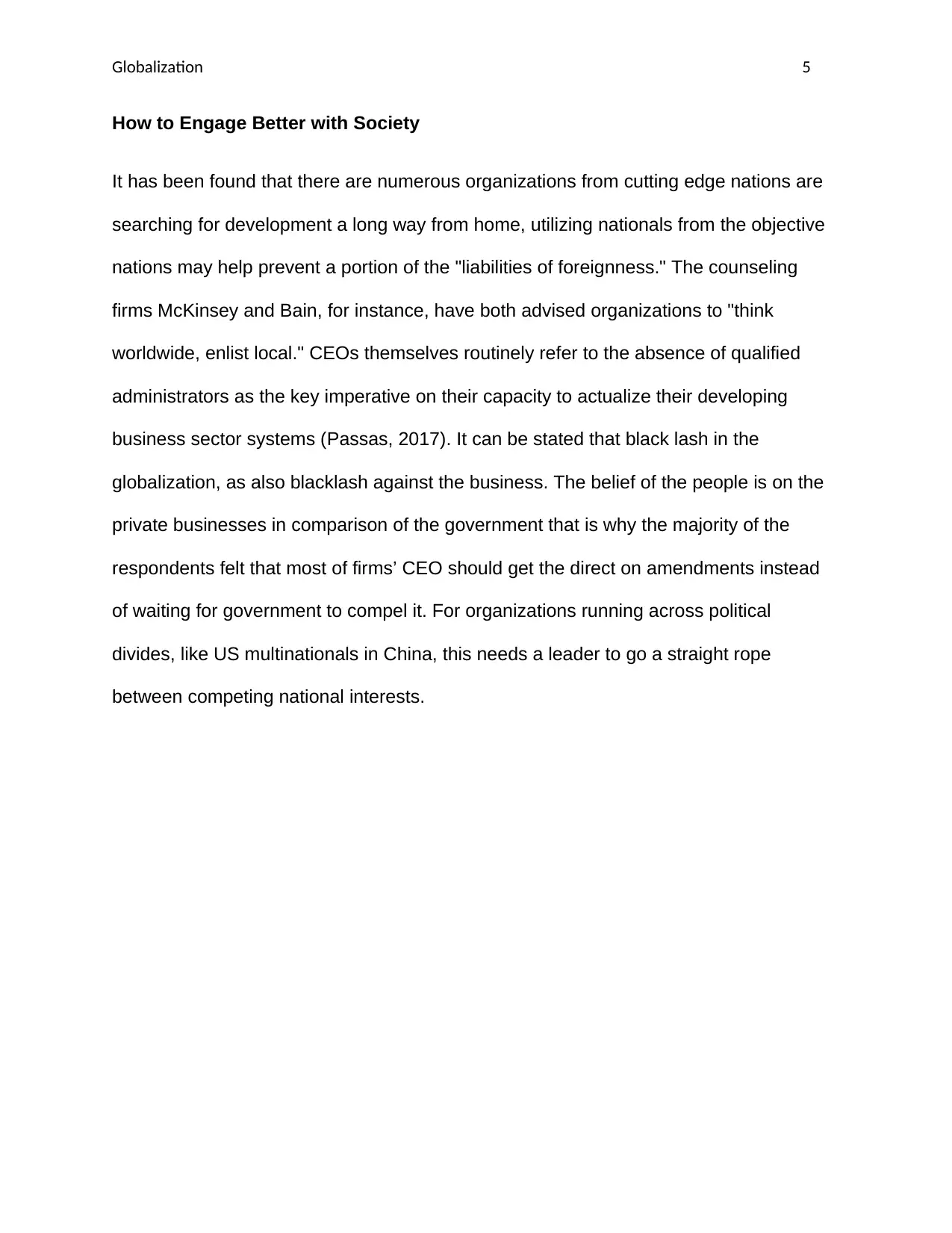
Globalization 5
How to Engage Better with Society
It has been found that there are numerous organizations from cutting edge nations are
searching for development a long way from home, utilizing nationals from the objective
nations may help prevent a portion of the "liabilities of foreignness." The counseling
firms McKinsey and Bain, for instance, have both advised organizations to "think
worldwide, enlist local." CEOs themselves routinely refer to the absence of qualified
administrators as the key imperative on their capacity to actualize their developing
business sector systems (Passas, 2017). It can be stated that black lash in the
globalization, as also blacklash against the business. The belief of the people is on the
private businesses in comparison of the government that is why the majority of the
respondents felt that most of firms’ CEO should get the direct on amendments instead
of waiting for government to compel it. For organizations running across political
divides, like US multinationals in China, this needs a leader to go a straight rope
between competing national interests.
How to Engage Better with Society
It has been found that there are numerous organizations from cutting edge nations are
searching for development a long way from home, utilizing nationals from the objective
nations may help prevent a portion of the "liabilities of foreignness." The counseling
firms McKinsey and Bain, for instance, have both advised organizations to "think
worldwide, enlist local." CEOs themselves routinely refer to the absence of qualified
administrators as the key imperative on their capacity to actualize their developing
business sector systems (Passas, 2017). It can be stated that black lash in the
globalization, as also blacklash against the business. The belief of the people is on the
private businesses in comparison of the government that is why the majority of the
respondents felt that most of firms’ CEO should get the direct on amendments instead
of waiting for government to compel it. For organizations running across political
divides, like US multinationals in China, this needs a leader to go a straight rope
between competing national interests.
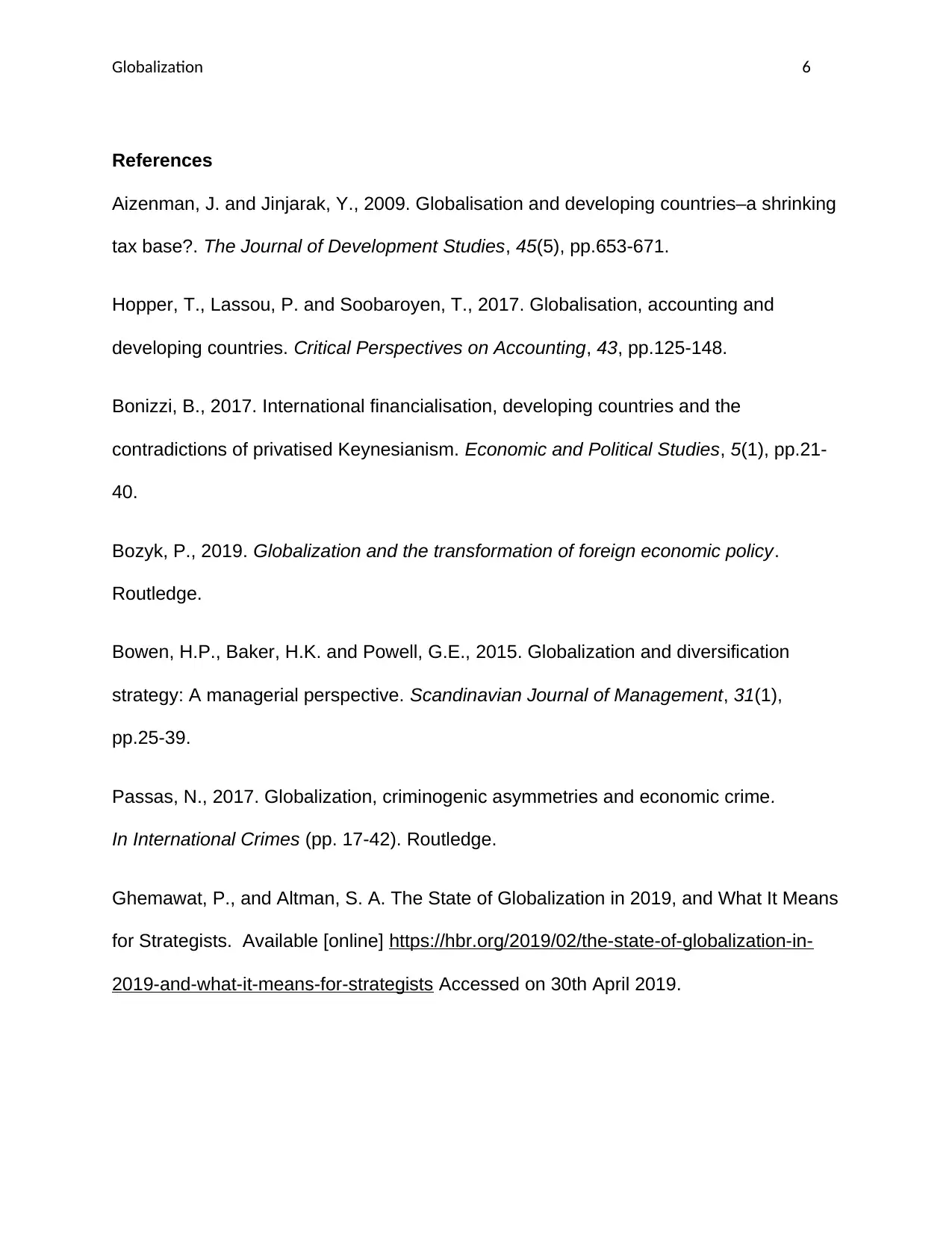
Globalization 6
References
Aizenman, J. and Jinjarak, Y., 2009. Globalisation and developing countries–a shrinking
tax base?. The Journal of Development Studies, 45(5), pp.653-671.
Hopper, T., Lassou, P. and Soobaroyen, T., 2017. Globalisation, accounting and
developing countries. Critical Perspectives on Accounting, 43, pp.125-148.
Bonizzi, B., 2017. International financialisation, developing countries and the
contradictions of privatised Keynesianism. Economic and Political Studies, 5(1), pp.21-
40.
Bozyk, P., 2019. Globalization and the transformation of foreign economic policy.
Routledge.
Bowen, H.P., Baker, H.K. and Powell, G.E., 2015. Globalization and diversification
strategy: A managerial perspective. Scandinavian Journal of Management, 31(1),
pp.25-39.
Passas, N., 2017. Globalization, criminogenic asymmetries and economic crime.
In International Crimes (pp. 17-42). Routledge.
Ghemawat, P., and Altman, S. A. The State of Globalization in 2019, and What It Means
for Strategists. Available [online] https://hbr.org/2019/02/the-state-of-globalization-in-
2019-and-what-it-means-for-strategists Accessed on 30th April 2019.
References
Aizenman, J. and Jinjarak, Y., 2009. Globalisation and developing countries–a shrinking
tax base?. The Journal of Development Studies, 45(5), pp.653-671.
Hopper, T., Lassou, P. and Soobaroyen, T., 2017. Globalisation, accounting and
developing countries. Critical Perspectives on Accounting, 43, pp.125-148.
Bonizzi, B., 2017. International financialisation, developing countries and the
contradictions of privatised Keynesianism. Economic and Political Studies, 5(1), pp.21-
40.
Bozyk, P., 2019. Globalization and the transformation of foreign economic policy.
Routledge.
Bowen, H.P., Baker, H.K. and Powell, G.E., 2015. Globalization and diversification
strategy: A managerial perspective. Scandinavian Journal of Management, 31(1),
pp.25-39.
Passas, N., 2017. Globalization, criminogenic asymmetries and economic crime.
In International Crimes (pp. 17-42). Routledge.
Ghemawat, P., and Altman, S. A. The State of Globalization in 2019, and What It Means
for Strategists. Available [online] https://hbr.org/2019/02/the-state-of-globalization-in-
2019-and-what-it-means-for-strategists Accessed on 30th April 2019.
⊘ This is a preview!⊘
Do you want full access?
Subscribe today to unlock all pages.

Trusted by 1+ million students worldwide
1 out of 6
Related Documents
Your All-in-One AI-Powered Toolkit for Academic Success.
+13062052269
info@desklib.com
Available 24*7 on WhatsApp / Email
![[object Object]](/_next/static/media/star-bottom.7253800d.svg)
Unlock your academic potential
Copyright © 2020–2025 A2Z Services. All Rights Reserved. Developed and managed by ZUCOL.





